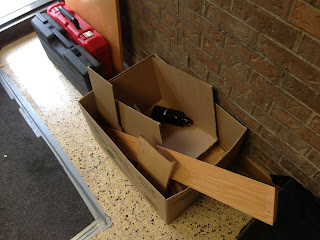Lets get updated!
First off,
Here we have a modification from the initial design, I realized that if we did a Plexiglas side, it would look great! For the first run anyways, However, due to this unit being stored in a wood shop, it would eventually be COVERED in sawdust, and having a little under 1/4" gap between the track guardrail and the Plexiglas would end up full of sawdust with no way of removing it.
To combat this problem, I simply made up the difference in height with a piece of material 5/8" wide (because that's how wide the original oak Plexiglas supports were), and as tall as the track barrier. It just so happens that after I do that, the windows are 3.5" tall, which is the height of a 2x4 standing on it's narrow side.
After I Grooved a 1/4" hole into the new Plexiglas supports and made the front pillars/Race Time Bar supports, as well as grooving those 1/4", I made a tongue on the bottom of the front pillars so they would slide in to secure them. The grooves are slightly offset toward the track so that the pillars only fit in one way for ease of re-assembly.
You may be wondering why the groove is 1/4" if I'm using 1/8" Plexiglas. The reason for this is safety, I am using two pieces (not laminated), placed side by side in the slot. Should one piece be cracked or penetrated by a object such as an axel shaft or splinter of wood shattering off of a failed model dragster, there is a good chance that it would hit the second piece of glass after losing most of it's momentum in the first piece, therefore either imbedding itself or becoming lodged in between the two pieces.
Here we see how I cut the Plexiglas, I realized after, I could've saved myself the trouble and set-up time by cutting it on the Mitre saw.
Here is the final fitting of the Plexiglas for one wall. The pillar tongue is not glued or nailed in place and is simply friction mounted to the barrier wall. it is held in place from above by a single 3" wood screw going vertically through the top Plexiglas support.
In the next update, I will have the full unit finally assembled and preparing for the electrical. I look forward to getting that and the program done. If anyone can figure out how to program for this thing, and wants to, I would most certainly be willing to test it. To collaborate, send an e-mail with your intentions to cal920c@gmail.com. Be sure to include Modelcarlauncher.blogspot.ca in the subject line.



























